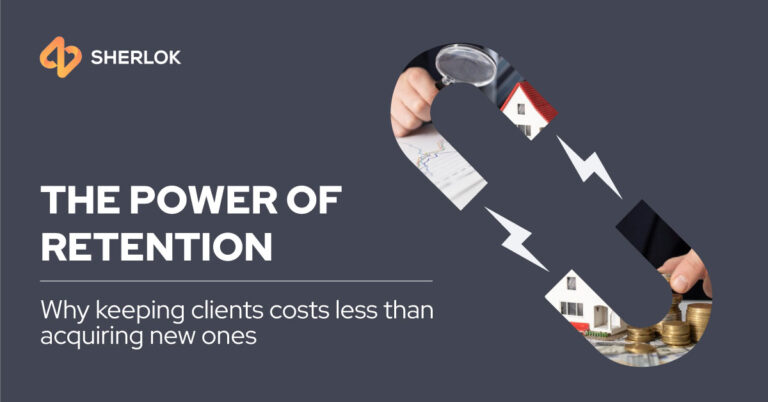In the competitive world of mortgage broking, client churn—when clients decide to take their business elsewhere—can significantly impact your growth and profits. Watching a client leave, especially after you’ve invested considerable effort into building that relationship, is always disheartening. But the good news is that you don’t have to sit back and let it happen. By recognizing early warning signs and knowing how to respond, you can keep your clients loyal and satisfied.
So, what are these signs, and how should you respond when you notice them? Let’s break it down.
The Subtle Signs Your Client Might Be Slipping Away
Client churn doesn’t happen overnight. There are usually subtle indicators that can give you an early warning before a client decides to leave. The key is to identify these signals early and take proactive steps to strengthen the relationship.
- Lack of Engagement: A drop in communication is often a red flag. If a previously engaged client starts ignoring your emails or misses scheduled follow-ups, it might indicate dissatisfaction. For example, if a client stops responding to your monthly newsletters, it’s time to check in and address any potential issues.
- Increased Interest in Market Trends: A sudden increase in a client’s interest in market trends or mortgage advice could signal they are rethinking their mortgage. If a client frequently inquires about interest rate changes or Reserve Bank decisions, they may be exploring alternatives. This is your opportunity to provide timely, relevant insights that reaffirm your value.
- Frequent Complaints or Negative Feedback: An increase in complaints is a clear sign of dissatisfaction. If a client regularly provides negative feedback about your service or the mortgage product, it could be a precursor to them leaving. Addressing these concerns promptly can turn the situation around.
- Changes in Financial Circumstances: Significant financial changes, such as job loss or major expenses, can prompt a client to reconsider their mortgage options. For example, if a client experiences a financial setback, they may seek a broker who can offer better advice or more flexible solutions. Being proactive in these situations can help retain the client’s trust.
How to Turn Things Around Before It’s Too Late
Identifying these warning signs is just the first step. Taking timely and effective action is crucial to retaining your clients.
Re-engage with Tailored Communication
When a client becomes less engaged, it’s crucial to reach out with a personalized touch. Instead of a generic follow-up, send a message that directly acknowledges their situation. For example, if a client hasn’t responded to recent communications, send a personalized email that acknowledges the silence, such as: “I noticed we haven’t connected in a while. Is there anything specific on your mind that I can assist with?” This approach shows that you’re attentive and genuinely interested in their needs, which can help rebuild the relationship and reignite their trust.
Offer Strategic Rate Reviews
When clients start looking elsewhere for rate reviews, it’s an opportunity to showcase the value you can bring. Don’t just provide them with the current rate options—offer a comprehensive analysis of their mortgage in relation to the latest market trends. For instance, you might say: “I’ve reviewed your current mortgage and found a few competitive options that could save you money in the long run, especially if you’re considering paying off your mortgage sooner or investing in additional properties.” By doing so, you not only present viable alternatives but also highlight why staying with your brokerage is beneficial for their long-term financial goals.
Deliver Customized Market Insights
For clients interested in market trends, it’s important to go beyond basic updates. Offer a detailed, one-on-one consultation that focuses on how current market conditions specifically affect their mortgage. For example, if a client is curious about rising interest rates, you might say: “Given the recent trends in interest rates, I’ve identified some strategies that could help you manage your mortgage more effectively. Let’s discuss how these changes might impact your financial plans.” This personalized approach not only addresses their concerns but also solidifies your position as their trusted financial advisor.
Resolve Complaints with Immediate Action
Handling complaints quickly and effectively can turn a negative situation into an opportunity to build stronger relationships. If a client expresses dissatisfaction, respond immediately and follow through with concrete actions. For example, if a client is unhappy with the response time for their inquiries, you could say: “I understand your concerns and have implemented a new protocol to ensure quicker responses moving forward. I’d like to check in with you next week to ensure you’re satisfied with the improvements.” This proactive approach not only resolves the issue but also demonstrates your commitment to their satisfaction.
Adapt to Evolving Financial Needs
When a client’s financial circumstances change, your ability to offer flexible, tailored solutions can make all the difference. Whether they’ve experienced a job loss or are dealing with unexpected expenses, show that you’re ready to adjust their mortgage strategy accordingly. For instance, you might suggest: “Given the recent changes in your financial situation, I’ve looked into some refinancing options that could reduce your monthly payments and ease your financial burden. Let’s explore these together.” By aligning your services with their new needs, you reinforce your role as a supportive and adaptable partner in their financial journey.
Creating Efficient Systems and Processes
Managing client churn doesn’t have to be overwhelming. By setting up efficient systems and leveraging technology, you can maintain strong client relationships without burning out.
- Utilize CRM Systems: Implement a Customer Relationship Management (CRM) system to monitor client interactions and engagement levels. Automated alerts can help you respond promptly to decreased communication or engagement.
- Leverage Data Analytics: Use data analytics tools to track client behavior patterns, such as increased interest in market trends or rate review requests. Tailor your communication and services based on these insights to meet your clients’ needs proactively.
- Regularly Review Client Portfolios: Schedule routine portfolio reviews to provide timely advice and adjustments. Automated tools can assist in tracking and analyzing client data, allowing you to stay ahead of potential issues.
- Implement Feedback Loops: Create simple, accessible channels for clients to provide feedback, such as online surveys or follow-up calls. Use this feedback to make continuous improvements and address concerns before they escalate.
Outsourcing to Reduce Your Workload
Outsourcing can be an effective way to manage routine tasks, freeing up your time to focus on client relationships.
- Outsource Routine Tasks: Consider outsourcing data entry or document management to reduce your workload. Virtual assistants or document management platforms can handle these tasks efficiently.
- Engage Third-Party Services: Utilize third-party services for rate comparisons or market insights, allowing you to offer clients competitive options without doing all the research yourself.
- Automate Communication: Implement automated communication tools for routine updates and reminders. Email marketing platforms and automated follow-up systems can manage regular client interactions, allowing you to focus on more critical tasks.
Conclusion
Effectively managing client churn involves recognizing early warning signs, taking prompt action, and setting up efficient systems. By leveraging CRM systems, data analytics, and outsourcing, you can streamline your processes and minimize client churn. These strategies not only help retain clients but also enhance your brokerage’s reputation for excellent service. Implement these practices to ensure your clients remain satisfied and loyal, positioning your brokerage for long-term success.





